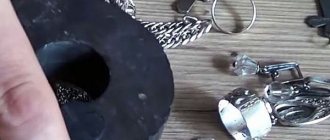Why is marking needed?
Symbols and signs printed on the packaging allow the consumer to obtain maximum information about the products being purchased.
With the help of drawings, drawings and product labeling established by GOST, buyers can find out what the product is made of, what its shelf life and storage procedure are, and what its consumer properties are. Law No. 2300-1 of 02/07/1992 “On the Protection of Consumer Rights” states that manufacturers are obliged to inform their customers about the main characteristics of the product. Requirements for product labeling imply that the packaging contains information about the country of origin, the name and address of the manufacturer, technical, consumer and operational properties, product content, volume and weight, expiration and storage dates and other qualities.
Product labeling allows the consumer not only to become familiar with the specific properties of the product, but also to identify a specific product and its manufacturer. Based on the markers indicated on the packaging, you can understand whether the product meets state standards and safety requirements, whether mandatory or voluntary certification has been carried out, and whether the product has specific characteristics or features in production and consumption.
Requirements for packaging and labeling of goods are established by the state standard (GOST) and technical regulations of the Customs Union No. TR TS 005/2011. All necessary information must be placed on the packaging or label. If we are talking about food products, then their packaging and labeling must be carried out in accordance with GOST and on the basis of 29-FZ of 01/02/2000 “On the quality and safety of food products”.
Shape tolerances
This type of permitted deviation is caused by processing inaccuracies that occur due to the actual capabilities of the processing equipment.
These include:
- straightforwardness;
- planes;
- mismatch of the circle shape (these include: roundness; ovality tolerance);
- change in the shape of a cylinder - cylindricity tolerance.
The first category includes the following deviations:
- the shape of the processed surface (the planar pattern is disrupted, the radius of the machined shaft changes, the geometry of figures with flat edges is disrupted);
- the parallelism and perpendicular arrangement of surfaces between each other or adjacent parts is disrupted;
- different roughness appears along the length, cross-section, and circumference.
The parameter values are assessed by comparing the nominal surface (indicated in the drawing) and the real one (obtained on machines of a given accuracy class). The resulting deviations allow us to calculate the required tolerance.
A change in the radius of the finished product relative to that specified in the drawing is called roundness. To prevent possible negative consequences during operation, a roundness tolerance is introduced. When examining a part in one of the planes, the required tolerance of the longitudinal section profile is determined.
The nature of the mutual curvature of the arrangement of planes is divided into the following types:
- general parallelism (compared to a line directed along the surface);
- perpendicularity and intersection of axes (the preservation of a right angle throughout the entire surface is checked);
- tilt;
- symmetry (relative to the selected axis).
The flatness tolerance determines the amount of permitted deviation from the designated level. The main characteristic is the so-called tolerance zone. It is designated in a selected area, which is located between planes for which strict parallelism parameters must be observed. The distance to the surface is determined by existing standards. Monitoring the deviation of these parameters from those specified in the drawing is indicated on the profilogram.
Which products must be labeled?
Although the composition of the label is voluntary for manufacturers, a certain list of products is subject to mandatory certification with subsequent confirmation of documentary compliance with established quality and safety standards. The list of such products was approved by RF PP No. 982 dated 01/01/2009.
If products are not included in this list, then product labeling is voluntary. The main task of any seller is to attract buyers. Therefore, labeling is necessary. Indeed, thanks to certain signs, symbols, pictograms, bar codes and QR codes, the consumer learns about the product even before purchasing it. Awareness and confidence makes a purchase more likely. That is why almost every product is marked. Recommendations for marking are also contained in RF PP No. 55.
Annual production program for the production of gears
| Name and part number | steel grade | Overall dimensions of parts | Weight 1 pc. in kg | Annual program* | |
| Gear | |||||
| Gear | |||||
| Gear | |||||
| TOTAL: | |||||
Note:
The annual production program for the production of gears is 185605 kg or 4813 pcs.
Where to find labeling requirements
All requirements for marking according to GOST are specified in state standards for various types of manufactured products. Any designation on the packaging is direct information for the buyer. All markings must be clearly marked and inscriptions must be legible. Signs need to be contrasting so that they stand out and do not merge with the packaging design. The symbols should not deteriorate due to time of storage, use and environmental influences (get wet or fade in the sun). It is recommended that markers display the maximum amount of information about the consumer properties of the product, including specific conditions of use. All information must be indicated clearly and understandably so that the consumer does not have another option for using the product, which could pose a threat to health and life.
Key labeling requirements do not depend on the scope of use of the product by the consumer:
- An unlimited number of symbols can be placed on the packaging, but their main task is to guarantee the quality of the safety of the product for the consumer.
- All designations must strictly correspond to the scope of application of the product.
- If the packaging does not allow the display of markers, all consumption characteristics are included in the documentation accompanying the products. The accompanying documents also indicate local regulatory conditions for product labeling.
Responsibility for the correctness and reliability of the data indicated on the packaging lies with the person directly performing the application.
Stamp for burning on a soldering iron (for making an impression on wood, leather)
What cliche size should I choose?
The size of the cliche is determined primarily by needs. Needs should be divided into strictly regulated (GOST, technical specifications, drawing) and relatively free, i.e. allowing options.
In the first case, everything is adjusted to the regulations. Secondly, it will be useful to know that the larger the area of the cliche, the greater the vulnerability from unevenness of the working surface. Not everything that looks smooth actually is. We guarantee an absolutely flat surface of the cliche relief. A hard, uneven surface (wood, plastic) makes it difficult to make a high-quality impression. In such cases, the less cliché, the less this vulnerability. Consider the feasibility of making a large cliché. Choose smaller clichés if possible.
Which heater should I choose?
The speed at which the cliche is heated to operating temperature depends on the power of the heater. The larger the cliche area in the size range for a specific heater, the longer the cliche takes to heat up. The more powerful the heater, the faster it will heat the cliche.
We have selected a set of stamps and offer a heater designed so that it heats the largest cliche in its size range in no more than 30 minutes at room temperature without drafts.
In the order form you will be offered the opportunity to install a more powerful heater or two heaters per cliche.
When ordering a brand for burning, consider the following rules:
1. The larger the area, the more difficult it is to make a high-quality print.
2. The larger the cliche, the more powerful the heater should be.
3. The engraving depth must be selected depending on the degree of surface roughness. The standard relief depth is 2 mm. This depth was suitable in all cases known to us. We can go deeper, but this is not always advisable.
4. On black leather, the imprint will be almost invisible.
How to understand what diameter range your cliche is in?
The size range determines the power of the heater and the price of the stamp. Determining the size range is easy if you have decided on the size of the stamp cliche. The diameter into which the cliche can be inserted is the diameter of the stamp.
Having found out the diameter, you can understand what range it falls into:
Types of markings
Markers are classified into production and trade. Grouping is carried out in accordance with the intended use of symbolism.
Manufacturing marks are applied directly by the manufacturer in accordance with the provisions of the Consumer Protection Law and other regulations. Production markers include labels, necklaces, various inserts, tags, tags and control tapes. Manufacturers can also put stamps or marks on products (or packaging). The type of marker depends on the type of product and its area of application. Symbols are necessary to certify the quality and safety of consumption and protect manufactured products from counterfeiting.
Trade markers are used by suppliers, distributors or stores that sell goods. With the help of trade marking, consumers can obtain information about the seller and the price of the product. Trade markings include cash receipts, sales receipts, and price tags. All data in such documents must be indicated in accordance with the rules of RF PP No. 55.
For example, this is what a sample food label looks like:
Device characteristics
An electric metal marker (EM) has been used in production practice for about 40 years. It is known by many names:
- electric spark marker;
- electrograph;
- electric pencil;
- arcograph.
EM is often used for marking:
- metalworking tools;
- measuring instrument;
- cutting tool;
- printed circuit boards;
- all kinds of tags or nameplates;
- surgical instrument;
- dental instruments;
- all kinds of metal parts.
Structurally, the electric marker is a system of 4 parts:
- Portable power source (usually designed for power from a regular household electrical network with a voltage of 220 V and a frequency of 50 Hz ).
- A vibrator handle with a built-in light filter (it has a regulator of the vibration frequency of the working part of the device).
- Replaceable tips made of spring steel or tungsten wire (diameter from 0.5 to 1 mm)
- Clamp and cable for connecting to the metal surface being processed.
The physical principle of operation of EM is the rapid erosion of the surface of the metal product being processed by breaking down the gap between the electrodes. Their role is played by the working part of the device (cathode) and the metal surface of the product (anode). The treated surface is covered with a series of small holes, with a diameter of 0.1 to 2 mm.
Labeling structure
The marker itself can consist of text, a picture and information symbols. All types of markings, or each one separately, can be presented on one package.
Text symbols are the most complete message in which the consumer can see mandatory and important information about the product. The text part is applied in accordance with GOST.
A design or logo includes richer data that still conveys specific consumer information. Some images, due to their visual effect, can increase sales of a particular product.
An information designation is a collection of encrypted data in the form of certain generally accepted symbols. Such markers can tell shoppers much more than some text directions. Such information includes bar codes and QR codes, trademarks, symbols for the care and use of products, safety values, environmental friendliness and conscious consumption.
For the most popular items, the rules stipulate the following places for stamping:
- On the inside - for rings;
- At the bottom - for dishes (dishes, glasses, vases, shot glasses), bottles;
- On the body - for key rings, boutonnieres, lighters, tie clips, cup holders, powder compacts, snuff boxes, flasks;
- On hooks or ears - for earrings, brooches, bells, buttons;
- On the rim - for tiaras;
- On parts available for branding - for bracelets, cufflinks, pendants, screw earrings;
- On a schnapper - for necklaces, necklaces;
- On a handle or lava - for table, dessert and tea spoons, scissors;
- On the blade - for knives;
- On the handles - for scissors;
- On stands - for photographic frames.
What will be the consequences of labeling violations?
Article 14.46 of the Code of Administrative Offenses determines the extent of liability for violations in the labeling of products subject to mandatory compliance.
If a product that is required to be labeled is labeled incorrectly, this may result in penalties for officials in the amount of 10,000 to 20,000 rubles and legal entities in the amount of 100,000 to 300,000 rubles.
If the above violations cause harm to the life or health of the consumer, the fine will be 30,000-50,000 rubles for an official and 700,000-1,000,000 rubles for a legal entity.
If a product that is required to be marked is not marked, then in this case a penalty may be applied in the form of a fine and criminal liability under Art. 171 of the Criminal Code of the Russian Federation. Unmarked products are subject to confiscation.
Ultraviolet printing
A primer is applied to the degreased metal, paint for a UV plotter is applied, and the design is “fixed” under the influence of ultraviolet light, because The ink used is photopolymerized and hardens on the surface. Marking equipment - UV inkjet printer
Pros:
● The method is suitable for any type of metal, alloys;
● Fast marking cycle: direct printing from a computer to metal, a few minutes from the start of the operation to the finished product;
● High quality printing with resolution up to 1400 DPI.
● Resistant to moisture, fading.
Minuses:
● Consumables. Ink (6500-9000 rubles per 1 liter of paint of the same color, consumption 10-20 ml*m2), all components in contact with paint: pump, wipers, cartridges, seals;
● Ultraviolet printing has more of a decorative function; for industrial purposes, its disadvantage is that the design can be “scraped off”.
Requirements for certain categories of goods
Labeling of packaging and the products themselves is carried out in strict accordance with the State Standard of the Russian Federation, the International Standard, as well as the Technical Regulations of the Customs Union.
For example, the procedure for labeling light industry products is determined by Article 9 (“Requirements for product labeling”) of the Decision of the Customs Union Commission dated 12/09/2011 No. 876 (as amended on 08/09/2016) On the adoption of the technical regulations of the Customs Union “On the safety of light industry products” (together with “TR CU 017/2011. Technical Regulations of the Customs Union. On the safety of light industry products”). The standard states that the marker must contain information about the name of the product, the country of origin, the name of the manufacturer and its legal address, production date and batch number, trademark (if any), raw material content, size, etc.
The same standard sets out the requirements for clothing labeling. Labeling of clothing and other textile products must additionally include the type and mass fraction of natural and chemical raw materials in the material, model name, symbols and instructions for caring for the product.
Food products are labeled in accordance with GOST R 51074-2003. Information provided:
- name of the product or product;
- name and legal address of the manufacturer;
- net weight - weight without packaging;
- compound;
- the nutritional value;
- sell-by date, shelf life, storage period and conditions;
- intended use for products intended for baby food, as well as for various biologically active additives, etc.
Requirements for the labeling of non-food products are established by GOST R 51121-97. Consumer information should include:
- name of the product and the country in which it was manufactured;
- name of the manufacturer and its legal address;
- scope and purpose of the product;
- main consumer properties;
- data on mandatory and voluntary certification;
- equipment, composition;
- date of manufacture and expiration date;
- if available, trademark;
- dimensions and net weight;
- barcode;
- other information.
Total tolerances of shape and location
Each of these parameters combines both permissible deviations. They arise as a result of the simultaneous manifestation of a change in geometric shape and the appearance of unevenness (roughness) of the treated surface. Therefore, using mathematical terminology, they say that the limit to which the difference between the standard and the real product should tend is considered the total tolerance of shape and location. The nature of the changes is determined by the method of comparison with the selected base objects. As such objects, proven structures or surfaces are chosen that can be considered standards, for example, various calibers.
Such tolerances are divided into the following categories:
- Beating. These include: radial, end, in a predetermined direction;
- All surface shapes.
Each of these categories has its own designation. The total runout tolerance is indicated by two oblique arrows in the form of vectors combined from below, directed from the lower left corner to the upper right. Comparison of shapes is made by combining both surfaces.
The field of this parameter is a limited area of space in which all points belonging to the surface must be located.
This field has specified geometric dimensions. It is oriented relative to the selected base so that the parallelism of the location can be checked. Examples of total tolerance indicate how much it is possible to change parameters without leading to rapid failure of the unit. This is especially true for mobile connections
Marking samples
| Sign | Decoding |
| This symbol indicates compliance of goods with the state standard - GOST. | |
| This marking reflects the net weight or weight of the product without packaging. | |
| This symbol indicates that the product is made from non-toxic material. | |
| This designation is used for frozen foods. | |
| With this marking, the manufacturer informs about the shelf life of the product after opening the package. | |
| This symbol indicates where the package should be opened. | |
| These icons represent the different types of plastic that can be recycled. | |
| The Möbius strip label is an international symbol for recycling. | |
| Indicates that all rules for labeling goods in the Customs Union and circulation of products on the market of member states of the Customs Union have been observed. | |
| Products with this designation do not contain transgenes and have been tested to contain foreign DNA. | |
| This designation will appear on all products that are not tested on animals. | |
| This label appears on organic products. |
When to brand
Welders are required to put their personal mark every time they perform work on connecting elements of critical structures. It is in this case that the most stringent requirements for reliability and operational safety are imposed on the final result. Such structures include lifting and transport, boiler, gas, oil production equipment, pipelines, building and other structures.
The stamp is placed on a free metal surface, the thickness of which is at least 6 mm. After applying the imprint, a test report and a welding log are filled out. In cases where the object is made of metal of less thickness or reinforcement is to be welded, the mark is not applied.









